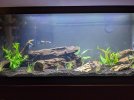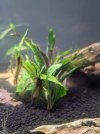I wasn't sure if this was better suited here for Tank issues or under freshwater. I apologize if it should be in the latter - mods feel free to move/close/etc.
I recently set up a freshwater planted tank for my 6 year old and 3 year old and I'm having some issues. I have kept saltwater tanks before so I am familiar with those, but freshwater is a totally new foray for me, and I'm not sure how best to figure out my issues.

Here is a current "snapshot" of the tank to hopefully help figure out what's going on in my tank.
Tank specs:
20L
Tidal 55 HOB filter, filter floss, small chemi-pure green pack (meant for nano/pico, but I didn't want to strip the water column totally), biomedia rocks - currently on full flow (used to reefs, thought more flow was better)
78-78F
Hygger 36W full spectrum LED, standard day cycle 6:30 am - 6:30 PM
Fluval plant stratum
Stock:
6 zebra and tiger nassarius snails (3 of each)
3 guppies
2 small otos
2 dwarf corys
1 neon tetra
(feed Fluval bug bites tropical 1 small pinch per day)
A few plants - I'm still learning these. Duckweed, java fern, dwarf grass, and one other that was "cabbage" but I don't know (there is a picture attached below)
Deceased (see below):
2 neon tetras
2 snails
1 ghost shrimp
Maintenance:
Weekly top offs with fresh water and Seachem Prime to remove chlorine, etc.
As needed use magnet scraper to remove stuff from glass
Monthly 25% water change
Current tank parameters:
Temp - 78-79F
ph - 6.8-7.0
Ammonia - <.25 (not exactly pure yellow on the API kit, so a bit more than 0.0 but not to the level of the 0.25ppm color either)
Nitrite and Nitrates - 0
On to the questions..
First, I seem to be having issues with livestock and I am not sure if it's my tank or just that the livestock had other issues? When I first got the tank cycled and the cloudy white-ish bacterial bloom was gone, I added a ghost shrimp and two snails and two otos to the tank to help with algae issues. The shrimp was dead within 12 hours... The shrimp were not great at the Petco where I got them, so I wasn't sure if it was just a store issue or tank issue and everything else seemed to be doing well.
A couple of days later, though, one of the zebra snails just stopped moving around. I thought it was dead so I took it out and it responded to being in my hand, so I knew it was alive. I put it back in the tank and it resumed semi-normal activities for a day or two and then it actually died.
I started checking the parameters more and the ammonia was a bit high, which I thought made sense since the snail had just died. I did a 25% water change and things seemed to be ok. I'm just running biomedia and filter floss.
Move forward a few weeks and the water remains crystal clear, the livestock seem happy, everything is good. I go to the LFS (a legit one this time, Atlanta Aquarium - love this place!) and pick up 2 dwarf corys, 5 more snails, 3 neon tetras, 3 guppies. Do a long acclimation and add them, all seems good. I added a 5g chemi-pure green to help with the sudden added bioload and dose some of the microbe-lift as well.
In the last week, two of the neon tetras have died and the original tiger snail did too. The first neon tetra was fine one moment and then wasn't - maybe it choked on a larger piece of food? The second started swimming odd, clearly a swim bladder infection, but I'm concerned it was an issue with my tank that caused it in the first place.
Water is slightly white-ish again (assuming bacterial bloom from the microbe-lift and added nutrients). Lots of algae on the substrate now, too.
Is the livestock loss just part of the deal, that sometimes livestock just won't make it? Or is it likely I have a bigger issue? I haven't tested phosphates or anything beyond the API master kit. I unfortunately don't have the space to quarantine livestock. We really want a lot of shrimp and some more fish, but there is no way I am buying more livestock and killing the poor things until I have a better handle on my tank, that's not fair to them (or my wallet and kids' feelings).
Second, what is going on with my plants? It seems they have roots growing from their leaves, which seems like they're either doing GREAT or there is a major issue and they are trying to find more nutrients.


Do I need to provide more fertilizer? I have Flourish but haven't used it because I don't want to see a huge spike in algae.
Third, The duckweed I have is growing well but now keeps getting pulled to the HOB (it wasn't doing this before so I don't know what changed) - any tips from folks on how to get the duckweed to kind of hang around the tank edges like it was before? I'd prefer to avoid a basket or something, I like the way they look floating naturally.
Again, sorry if this is the wrong channel for this thread, and thank y'all very much for any help or advice y'all provide.
cheers!
I recently set up a freshwater planted tank for my 6 year old and 3 year old and I'm having some issues. I have kept saltwater tanks before so I am familiar with those, but freshwater is a totally new foray for me, and I'm not sure how best to figure out my issues.

Here is a current "snapshot" of the tank to hopefully help figure out what's going on in my tank.
Tank specs:
20L
Tidal 55 HOB filter, filter floss, small chemi-pure green pack (meant for nano/pico, but I didn't want to strip the water column totally), biomedia rocks - currently on full flow (used to reefs, thought more flow was better)
78-78F
Hygger 36W full spectrum LED, standard day cycle 6:30 am - 6:30 PM
Fluval plant stratum
Stock:
6 zebra and tiger nassarius snails (3 of each)
3 guppies
2 small otos
2 dwarf corys
1 neon tetra
(feed Fluval bug bites tropical 1 small pinch per day)
A few plants - I'm still learning these. Duckweed, java fern, dwarf grass, and one other that was "cabbage" but I don't know (there is a picture attached below)
Deceased (see below):
2 neon tetras
2 snails
1 ghost shrimp
Maintenance:
Weekly top offs with fresh water and Seachem Prime to remove chlorine, etc.
As needed use magnet scraper to remove stuff from glass
Monthly 25% water change
Current tank parameters:
Temp - 78-79F
ph - 6.8-7.0
Ammonia - <.25 (not exactly pure yellow on the API kit, so a bit more than 0.0 but not to the level of the 0.25ppm color either)
Nitrite and Nitrates - 0
On to the questions..
First, I seem to be having issues with livestock and I am not sure if it's my tank or just that the livestock had other issues? When I first got the tank cycled and the cloudy white-ish bacterial bloom was gone, I added a ghost shrimp and two snails and two otos to the tank to help with algae issues. The shrimp was dead within 12 hours... The shrimp were not great at the Petco where I got them, so I wasn't sure if it was just a store issue or tank issue and everything else seemed to be doing well.
A couple of days later, though, one of the zebra snails just stopped moving around. I thought it was dead so I took it out and it responded to being in my hand, so I knew it was alive. I put it back in the tank and it resumed semi-normal activities for a day or two and then it actually died.
I started checking the parameters more and the ammonia was a bit high, which I thought made sense since the snail had just died. I did a 25% water change and things seemed to be ok. I'm just running biomedia and filter floss.
Move forward a few weeks and the water remains crystal clear, the livestock seem happy, everything is good. I go to the LFS (a legit one this time, Atlanta Aquarium - love this place!) and pick up 2 dwarf corys, 5 more snails, 3 neon tetras, 3 guppies. Do a long acclimation and add them, all seems good. I added a 5g chemi-pure green to help with the sudden added bioload and dose some of the microbe-lift as well.
In the last week, two of the neon tetras have died and the original tiger snail did too. The first neon tetra was fine one moment and then wasn't - maybe it choked on a larger piece of food? The second started swimming odd, clearly a swim bladder infection, but I'm concerned it was an issue with my tank that caused it in the first place.
Water is slightly white-ish again (assuming bacterial bloom from the microbe-lift and added nutrients). Lots of algae on the substrate now, too.
Is the livestock loss just part of the deal, that sometimes livestock just won't make it? Or is it likely I have a bigger issue? I haven't tested phosphates or anything beyond the API master kit. I unfortunately don't have the space to quarantine livestock. We really want a lot of shrimp and some more fish, but there is no way I am buying more livestock and killing the poor things until I have a better handle on my tank, that's not fair to them (or my wallet and kids' feelings).
Second, what is going on with my plants? It seems they have roots growing from their leaves, which seems like they're either doing GREAT or there is a major issue and they are trying to find more nutrients.


Do I need to provide more fertilizer? I have Flourish but haven't used it because I don't want to see a huge spike in algae.
Third, The duckweed I have is growing well but now keeps getting pulled to the HOB (it wasn't doing this before so I don't know what changed) - any tips from folks on how to get the duckweed to kind of hang around the tank edges like it was before? I'd prefer to avoid a basket or something, I like the way they look floating naturally.
Again, sorry if this is the wrong channel for this thread, and thank y'all very much for any help or advice y'all provide.
cheers!
